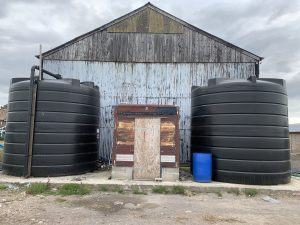At Brow Farm we like to do our bit to help the environment. So we looked into fitting more rainwater recovery systems on the farm. One new system harvests rainwater for our bird housing. A cleaning process means that our birds have safe drinking water.
Rainwater Recovery
Rainwater from the roofs of our main farm buildings is already diverted to a two-acre lake. That system has been in place for over ten years and enables us to irrigate salad and vegetable crops grown on the farm. For the new project we decided to use the roofs of the aviaries and an old barn. This large area collects enough water to supply the livestock year-round.

The Process
We wanted to use a low-pressure gravity system compatible with all our nipple drinkers. So we chose a spot at the top of a gentle slope for the water to be stored and processed. A concrete plinth to support the 35,000 litre storage tank was cast and the tank placed on top. Alongside it we sited a small storage shed with an electricity supply; the control shed. Our aviaries are on opposite sides of a path between them, so we fitted two small water tanks within the shed. Each tank supplies one group of buildings. This way we can medicate one or other groups of birds using the individual tanks as needed.
We installed new guttering all around the buildings. These drain into a downpipe that slopes gently from the far end to the large storage tank. Lesson learned here – never assume that your buildings are level. We found that our building sloped away from the storage tank by 150mm and had to compensate.
The next challenge was cleaning the water. The solution, a solenoid valve fitted to the outlet of the main storage tank.
How It Works
The control panel is initiated by the low-level float switch which activates the UV filter and starts a timer – this cleans the static water in the filter. The timer then switches on the solenoid valve and pump. Water is pumped into the main water tank until the high-level float switch is activated which turns off the pump, solenoid and UV filer. As water is drunk by the birds the water level drops, the low-level float switch comes on, and it all starts again.
We have ample rain to harvest in Lancashire. So when we knew that our system was working we invested in a second tank, feeding into the same control shed.
